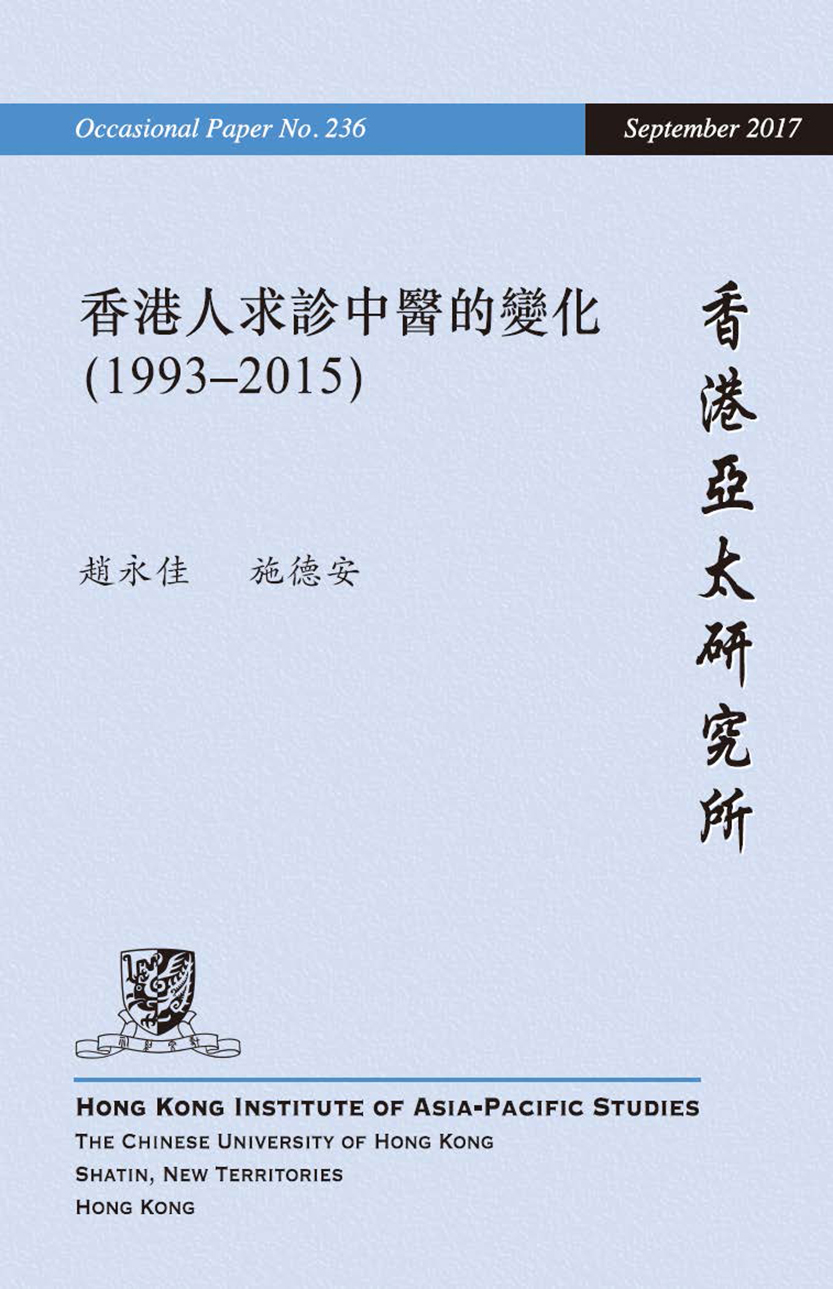HKIAPS Publications
(Changes in the Utilization of Chinese Medicine in Hong Kong [1993−2015])
Stephen W. K. CHIU and Tak-on SZE
Chinese/21.5 x 14 cm/paperback/ii+41 pages/published in September 2017
ISBN 978-962-441-236-9; list price: US$3.00 (HK$20.00)

趙永佳、施德安
回顧香港亞太研究所於1993、2004和2015年關於香港中醫求診情況的三個研究,我們可以初步瞭解中醫在經歷了約20年專業化發展後的現狀:2004和2015年的調查結果顯示市民對中醫的信任有著持續增加,中醫求診率在1993和2004年間有著明顯增長。這兩個趨勢顯示了早期的回歸後,中醫註冊及中醫藥的監管的成效。但在2015年的中醫求診率和2004年相近,求診率保持穩定,顯示了人們在求診時的實際選擇和對特定醫療的信心並不對應。造成這種不一致的因素包括醫療市場的結構以及人們的社會經濟水平。公營醫療系統並沒有提供中醫診療,人們只能跟私營的中醫師求診。專業化也使得中醫私人市場服務的診療收費持續增加,社經地位較低者尤其是年長群組,不一定能負擔日漸昂貴的中醫私人市場服務。這些情況都可能減少人們向中醫求診的機會。
另外,和過去相關研究有所不同,年長群組不再是中醫的主要求診者,也揭示了中醫經歷一系列的專業化過程後,私營市場不再能為他們提供廉價的服務;雖然他們對中醫有一定程度的信任,但受限於其社經狀況,他們可能更願意選擇西醫。我們建議政府考慮把中醫逐步全面納入公營醫療系統,也提高對長者的醫療資助,以及在自願醫保計劃的受保範圍涵蓋中醫門診及住院服務,以增加市民選擇中醫服務的機會。
Changes in the Utilization of Chinese Medicine in Hong Kong (1993-2015)
Stephen W. K. CHIU and Tak-on SZE
In this paper, we review three longitudinal surveys on the utilization of Chinese medicine (CM) in Hong Kong in 1993, 2004 and 2015, disclosing the development of CM utilization in the last 20 or so years. The result in 2004 and 2015 showed that Hong Kong citizens developed growing confidence towards CM. A significant growth in the utilization rate is also found between 1993 and 2004. These two trends suggest that the efficacy of the policies on CM registration and regulation in the early post-handover period. Nevertheless, the utilization rate of CM in 2015 was similar to that in 2004, and the leveling off in utilization reveals the loose correspondence between the actual choice of doctor consultation and one’s confidence level towards a particular mode of medicines. The factors causing this inconsistency could be the structure of health care market in Hong Kong and the socio-economic conditions of the users. The public health care sector does not provide CM services. People can only consult private CM practitioners. Meanwhile, the consultation fees of private CM practitioners have been increasing due to the professionalization of CM. The structure of the health care market determines the characteristics of CM users. Most people of a lower socio-economic status, especially the elderly, cannot afford the increasingly high consultation fees of private CM practitioners and have been switching to subsidized Western medicine services.
Moreover, our study reveals a different result from previous similar studies conducted in Hong Kong, in that it indicates that older people are no longer the main users of CM. This change may be because private services have become unaffordable as the result of professional development of CM. Older people still have confidence in CM, but their choice of medical services is determined by their socio-economic status. They prefer to access subsidized medical services in the public sector rather than relatively expensive CM, which is only provided in the private sector. We suggest that the Hong Kong government incorporate CM into the public health care sector, including in-patient and out-patient services in clinics and hospitals, in a step-by-step manner. It should also increase medical subsidies for elderly people. Moreover, it should expand the Voluntary Health Insurance Scheme’s area of coverage to include CM in-patient and out-patient services. We hope that this will lead to an increase in the use of CM services by Hong Kong people.
